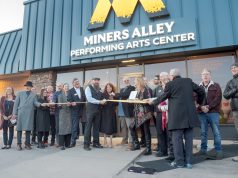
The most noticeable thing about Ira Glass, when Boulder Weekly reached him for an interview, is his voice — the nasally, soft-spoken, atypical radio voice that has broadcast stories on the public radio program This American Life since 1995. He says hi and introduces himself, but he doesn’t have to. His voice is instantly recognizable. He’s courteous, too. Glass is famous for the mile-a-minute pace at which he works, but he first asks if he should speak slowly to make it easier to take notes.
Glass is on the phone to promote his upcoming appearance in Boulder on Saturday, Sept. 21. In “Reinventing Radio: An Evening With Ira Glass,” Glass will discuss the history of his radio program and play outtakes and clips from the cutting room floor that never made it onto the show. He does this sort of thing once a month in a different city to promote the show, since, as he says, “We don’t have money to take out ads.” It’s an unconventional promotional effort, something he’s been doing for years.
“We wanted stations to make more money off our show than it cost,” Glass once told The New York Times while discussing his marketing efforts. “The flakier your mission, the fiercer you have to be on the business side.”
This American Life began taking stories about everyday life — tales of vacations gone bad, stories of people who decided to drastically change their lives, a look at the minds of undecided voters — and airing them in thoughtful, carefully considered ways. It wasn’t traditional news radio. But the format struck a chord with audiences and has since become a public radio institution, now broadcast on more than 500 stations to roughly 1.8 million listeners.
Since its inception, the radio program has evolved to tackle contemporary news, filtered through intriguing stories of individual people. Take, for example, murder rates in Chicago. This American Life recently broadcast at two-part, two-hour show on Harper High School, located in inner-city Chicago, where just last year, 21 current and recent students were wounded by gun violence, and eight more killed. Glass sent three producers down to the school for five months, where they sat as flies on the wall as the school navigated another traumatic school year. They came back with incredibly intimate and revealing stories from the high school. The program humanized the administrators, students and parents in a part of Chicago unfamiliar to the rest of the country.
Boulder Weekly spoke with Glass about his radio program, his reporting philosophy, the unique intimacy radio can convey, and more.
Boulder Weekly: How did This American Life start?
Ira Glass: On the radio, the radio show started as this journalistic project where we were taking the tools of journalism and applying it to stories that are much more small and personal than things reporters traditionally looked at. And the stories were stories in the old-fashioned, classic sense. There’s somebody in some situation, and something happens to them, and that person is relatable, and you want to find out what happens, and things happen to them and they change or learn something. There are funny moments and emotional moments. That’s what the radio show is built out of.
Over the years, as time has passed, we’ve more and more become interested as a staff at applying that kind of storytelling to things that are in the news. So when we tackle something that’s in the news, we’ll look for a person, some emotional way in.
Kind of a hook that will help tell the story, if the story is about statistics or politics.
We did a story about the Colorado state climatologist, a guy named Nolan Doesken. At the time that we did it, he was really debating about whether he should come out about the fact that the climate is changing, since so many of the people he is talking to, who are ranchers and farmers around the state, don’t believe in climate change. He worried that he was basically getting into a fight with people who wouldn’t believe him anyway. He was trying to decide what he wanted to say about it, and I feel that in this light of this very likable, smart guy, you could sort of see where the whole country was at, because you could see all the people who still disbelieved, and what is someone like Doesken, who feels like there is evidence that something is changing, what is he supposed to say or do? It spoke in a general way to a lot of where the country is, through him and through his dilemma about what he is going to say in this speech that he is about to give, as he traveled around the state talking to people.
Did you ever think that This American Life would have the legs that it does, that it would be as popular as it has become?
No. No. I mean, I thought that what it was going to be was a nice show that some people would like and so the level of popularity that it’s had has been a pleasant surprise.
What do you think is the thing about the show that attracts so many people?
I think people have the same relationship to it that I and the staff do. A really great story is fun to listen to. I feel like it doesn’t happen that often on the radio, and we work really hard to find good ones. It’s super simple. We’re looking for stuff that’s fun and entertaining, and it’s like, I feel like the audience’s relationship to it is really the same as mine and the producers’.
I’m kind of interested in how the story behind this piece on Harper High School came together.
That’s something I often talk about in my speech. Harper High School came about because last year, there were over 500 murders in Chicago. And as a staff we’re trying to figure out a way to cover that. We talked about different things, and we thought, “Oh, we cracked it.” Over Memorial Day, over 50 people were shot in one weekend, in one holiday weekend. So let’s just do these 50 people.
When we got into that, we [realized], “Oh, these cases are in court. Nobody is going to talk about it.” Once we dug into it and tried to do that, it turned out to be un-reportable in any sort of timely way.
Glass has worked on This American Life since 1995. | Photo by Nancy Updike
We heard about this high school, from a local story that somebody did that touched on one of the shootings there, one of the kids who was killed there. We thought, this would solve the problems that made the Memorial Day version of the story unproduceable. Basically with the Memorial Day thing we couldn’t get people to talk, whereas here, if the school participated in the story, when the next kid was murdered, we found this high school where 29 kids had been shot in the previous year. We just thought, well, when stuff happens, we’ll be able to figure out what happened. We won’t be in the situation where we were in with Memorial Day, where people were just shutting up about it.
Was it a difficult process to get them to agree to share these really traumatic moments with you guys?
I think the staff had the same sense that we did, that these things don’t get covered enough, that you don’t hear about these parts of the country where you have large parts of the country who are dealing with this trauma, who are witnessing so much violence. So the [school] staff, I think, was glad for the story to be out there. So no.
I thought parts of that piece really showcased the real potential of how radio can be used in storytelling. I remember hearing some of the interactions between the counselor and the student who shot his brother accidentally.
Oh my god, I know. What a sad story.
Then you guys made the decision to just let that go on for maybe two minutes. That seems like a very unconventional decision, but it was also very telling as to what radio can do. Can you maybe go into how you guys make those kinds of decisions on how to tell the story, how you make the decisions about how to best use radio in order to do that?
Well, you know, that story, that kid was much longer than two minutes, it was eight or 10 minutes. There were certain pieces of tape that were just two minutes. I mean, in a way, it’s dumb to say, but it’s sort of the kind of reporting where you go and hang out and you record everything, and then when things unfold on tape that seem especially compelling and revealing, you try to put it order where it will make the most sense. In a sense it’s kind of a dumb job, you just want to hang out, people say stuff, you try to tape it, and then you try to pick the most interesting parts and put it in order. In the case of that, radio is so intimate, that you can, you’re just right there with them when they’re trying to talk about it. When the counselor is trying to get the kid to talk about his grief over his little brother shooting himself, or rather his little brother being shot in this gun accident, where the two of them had this gun, and talking about how mad his mom is at him, and how hard it’s been at home, how it’s affected him, just all those things, radio, because you just hear the person’s voice, because you don’t see them, it’s just so easy to make an emotional connection with the people in the story.
Do you think that would even be able to transfer over in print?
I mean, I’m not a print person. I think it would be hard to let a quote run quite as long as print. Truthfully, I think a really skilled print reporter would be able to figure out how to get that same scene across in that story. But it’s much harder. The thing about radio, we send out the intern and the tape is just as intimate as if a super-experienced person goes out. That’s what radio does when it’s not trying to do anything in particular as it gives you that kind of intimacy. Whereas I think print, you have to be a very skillful person, or if you wanted to do this as TV, you would just have to shoot it in a way where it would just look like a film for it to have the same power as it would have in radio. You’d have to really light it beautifully and frame it beautifully, you know, where the level of craft you’d have to bring to it would be very extreme. For radio, that’s the thing that radio does.
I heard you once say that you guys toss out maybe half the ideas that you come up with. Is that still part of the process?
Yeah. It’s documentary work. In that way it’s different from when I worked on a daily news show. In more of a news journalism context, generally when you get assigned something, it gets on the radio or in the paper. This, because it’s documentary work, we just kind of run at a bunch of stuff and then wait and see what stuff works out the best and kill the rest. And that’s really one of the most important things that makes the show work, I think.
Ira Glass speaks at Chautauqua Auditorium at 7:30 p.m. on Saturday, Sept. 21. Tickets start at $40. 900 Baseline Road, Boulder, 303-440-7666.
Respond: [email protected]














